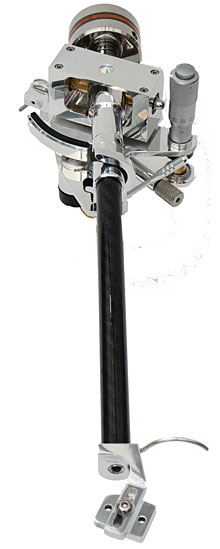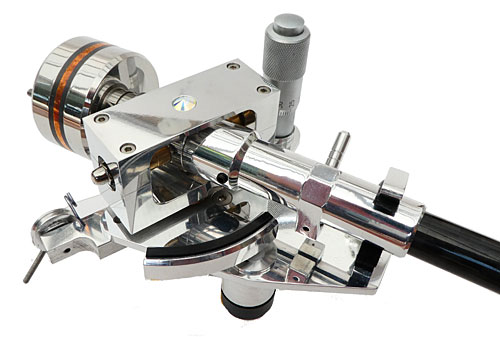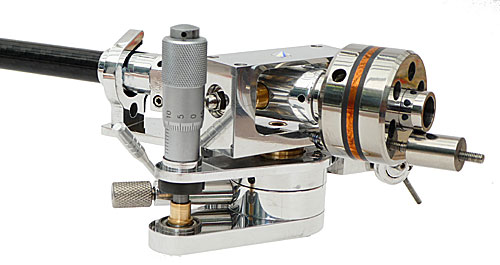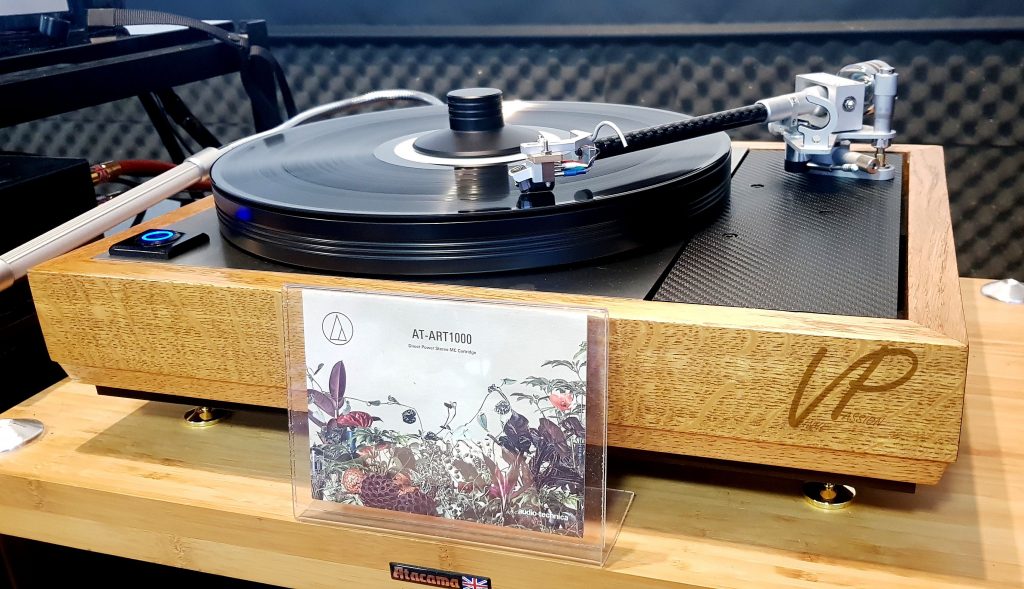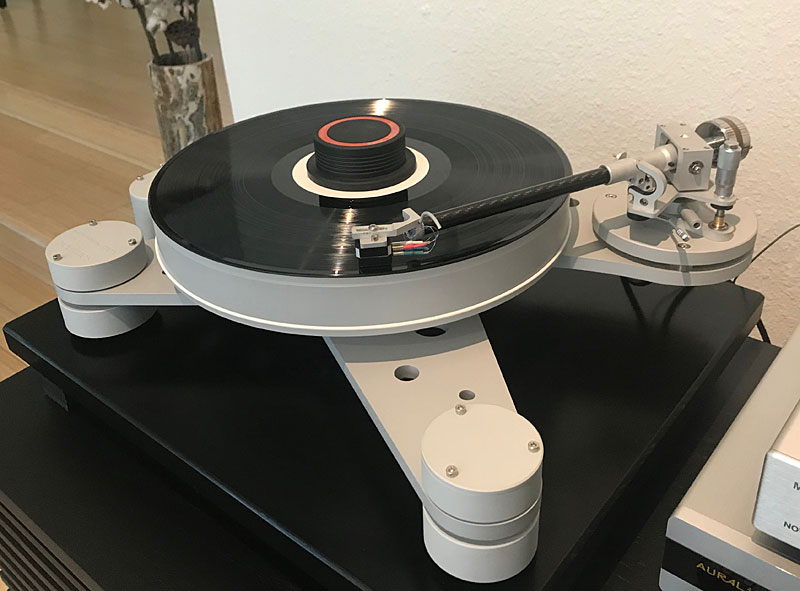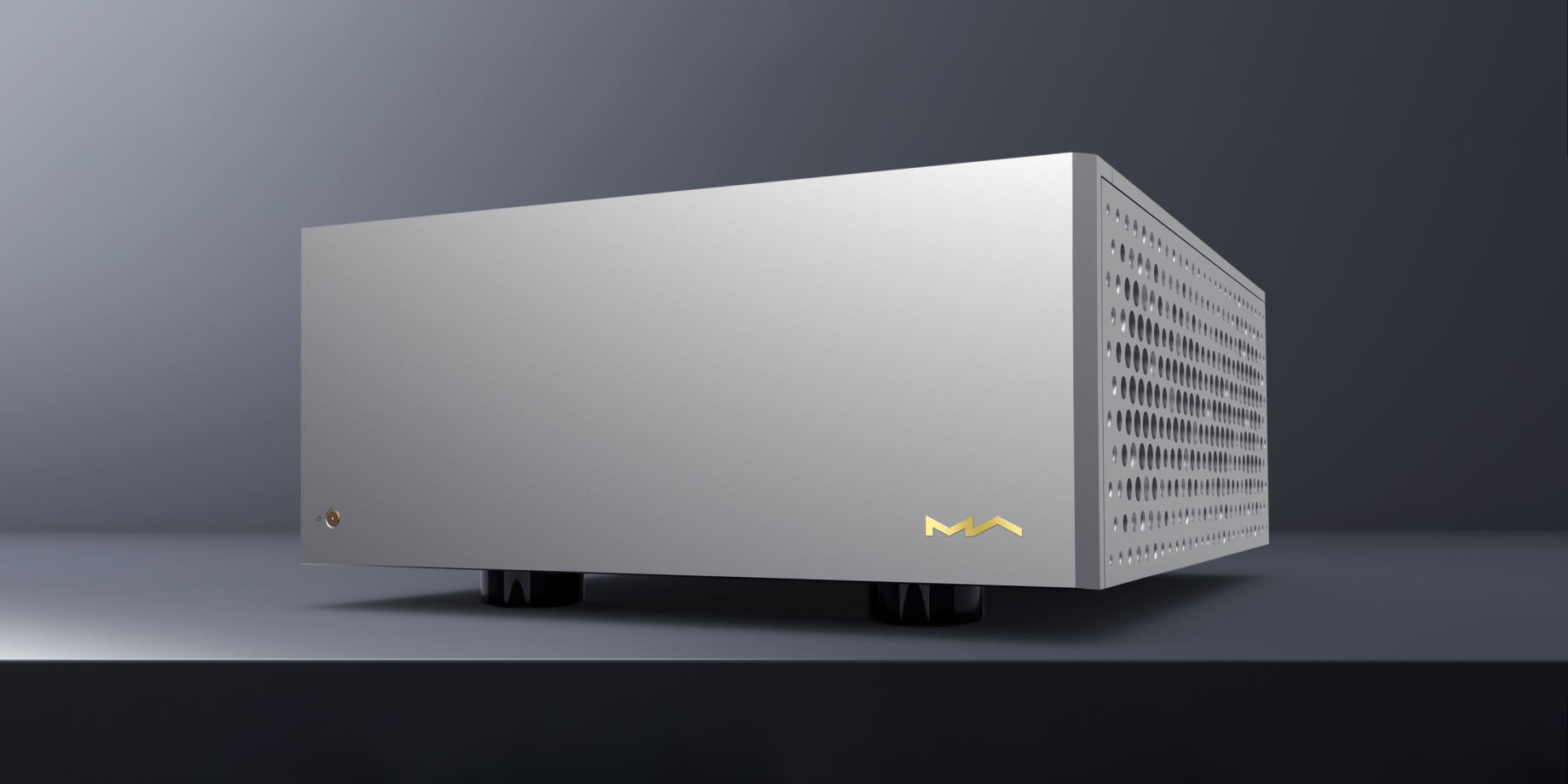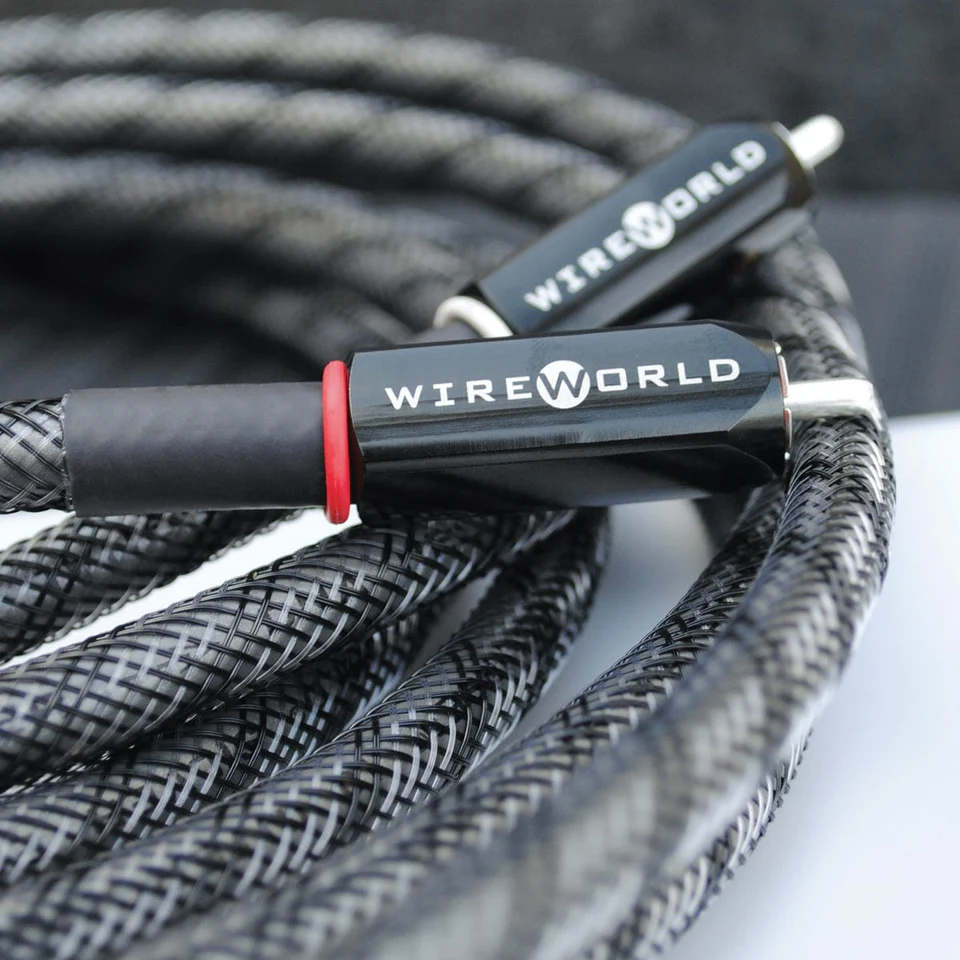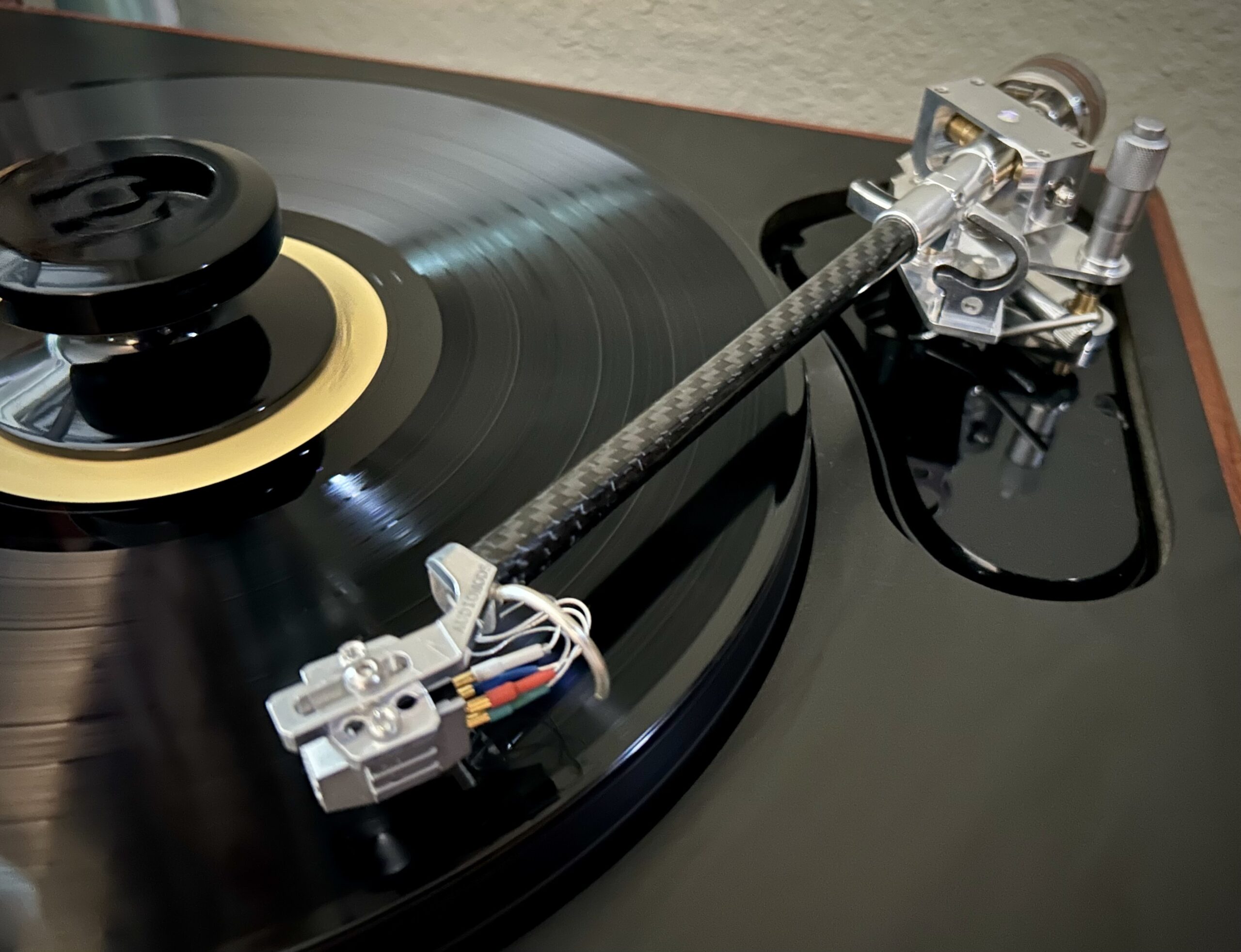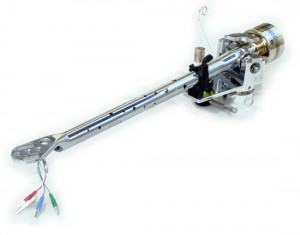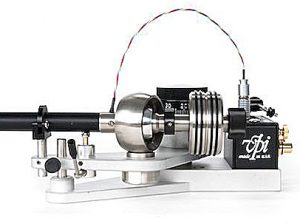Unless you have lived on a desert island for the last five years or so, it is unavoidable to notice that vinyl playback systems have stormed back from the abyss. Vintage turntables have become relevant, there are new cartridge manufacturers, ultrasonic record cleaning is a hot topic of discussion, and you can even go into department stores and see new vinyl albums for sale. However, as you focus closely on this analog landscape you will notice the absence of a meaningful selection of high-quality tonearms that can be considered affordably priced. Sure, there are some inexpensive options, but there are significant compromises to these tonearms. At the other end of the spectrum there are arms that cost the equivalent of a good used car. Yet vinylophiles should not despair, as Jeff Spall at Audiomods has rolled out the all new Series Six tone arm! This is an arm that sells for £985 ($1270) that showcases a two-layer carbon fiber arm wand, single run of cryogenically treated silver wiring, ceramic bearings, variable mass counterweight, and micro-meter VTA adjuster. Quite frankly, I am not aware of another handcrafted arm that is built with this level of precision at this price point. This is what our world has been missing, and the discerning hobbyist should take heart because the Series Six arm is what they have been looking for.
Carbon fiber is not a new material in the field of tonearm manufacturing, but it typically has been relegated to the use of relatively expensive arms. The advantages to carbon fiber over aluminum is a higher stiffness ratio along with increased internal damping properties. Damping of a carbon fiber tube is approximately four times greater, and yet only has 60% of the mass of a corresponding aluminum wand. Jeff did not just lop off a length of carbon fiber tubing and fashion a tonearm, as the Series Six is composed of inner and outer shells of varying thickness, and carbon fiber layers are bonded together with stiffening spacers. The purpose of this intricately designed arm tube is to efficiently dissipate unwanted energy within the arm before it corrupts the interface between cartridge and record. The head shell has been designed to have lower resonance properties, and happens to be easier to use when aligning a cartridge. The yoke and arm bearing assembly is noticeably robust, as it is machined from thick portions of aluminum.
The Series Six arm contains the design DNA of previous generation Audiomods tonearms, with several key elements creating the foundation for this arm. The bearing design debuted in the series Five arm; however, it now boasts a higher grade of ceramic bearings that are mounted in a revised bearing assembly which results in a lower coefficient of friction. The counterweight retains the variable mass design where the owner can add or subtract plates of lead and copper discs in order to accommodate a wide array of cartridges. The silver internal wire is now housed in Teflon tubing, and it receives a deep cryogenic treatment. Silver-plated phosphor bronze cartridge tags are also cryogenically treated, and the KLE bullet RCA ends are the termination of choice for Jeff. Finally, the micro-meter VTA adjuster is available on this arm, which allows for accurate and repeatable stylus rake angle settings. This micro-meter device is a tried and true design that would be worthy of being used on top tier arms, how Jeff is able to include it at this price point is something I have pondered more than once.
The Series Six arm also incorporates a few new twists, and one of the most notable is the head shell. This is a skeletal design intended to eliminate unwanted resonance nodes. There are cartridge mounting plates that differ in mass, and can accommodate pickups that have varying compliance characteristics. The single point bolt system simplifies the cartridge alignment process, and I can attest to benefits provided when installing a cartridge. The Series Six also has a set screw in the sleeve the arm tube is anchored to, and which allows for a degree of azimuth adjustment. The previous arm had a nicely executed anti-skate system, so I was surprised to see that Jeff has redesigned this element of the arm. The revised assembly is neatly located out of the way, and has a pivoting base that varies the anti-skate force in relation to the position of the arm. Greater anti-skate forces are applied when the arm reaches the inner grooves instead of applying an even force across the whole of the record, which is exactly how you need this event to occur. The method of how anti-skate on an arm is executed is almost an afterthought to most hobbyists, the system Jeff has designed speaks to his focused and thoughtful approach to creating the best arm he can envision.
The Audiomods Series Six tonearm was installed on a SOTA Cosmos Eclipse table as well as a Brinkmann Bardo. The cartridges used are a ZYX 4D and an Ortofon A90. My primary phono stage is an Esoteric E-03, which feeds a Halcro DM8 preamp and First Watt F7 amplifier. JBL 4365 studio monitors are my reference speakers, which are augmented with a pair of Velodyne HGS12 subwoofers. Power conditioning duties are handled by a PS Audio Perfectwave 10 conditioner in conjunction with PI Audio Group power cords. Wireworld Eclipse 8 speaker wire and Analysis Plus Silver Apex interconnects complete the system.
Defining the contribution of a tonearm within the context of an analog system is a difficult task to accomplish. Where do the effects of a subcomponent begin or end, and to what degree does any portion of the turntable have on the final sound? I chose to install the Audiomods tone arm first on the SOTA Cosmos Eclipse with the ZYX 4D cartridge, and then switched to the Ortofon A90. I repeated this process on the Brinkmann Bardo and listened to the same tracks while comparing the sound to the notes I took during the first half of my listening sessions. The common thread that wove through all my listening sessions is that the Series Six tone arm is as neutral an arm as a person could ever imagine at this price point. It has a degree of refinement that outpaces its price and keeps it competitive with arms that are significantly more expensive. With the Ortofon A90 installed, the notable changes I heard in my listening sessions are differences in presentation of the two tables themselves. The SOTA Cosmos is expansive in portraying acoustic space, more vibrant in terms of harmonic structure, and denser in texture in the all-important midrange sections. While the Brinkmann Bardo is utterly precise in tonal balance, to the point where you can envision this is what a master tape sounds like. Bass response extends as deep as the SOTA but with slightly better definition. The soundstage is a bit more compact, with slightly less depth, yet performers are clearly formed within the context of this acoustic venue. Essentially the Series Six tonearm got out of the way, and allowed the cartridges to do their job, and the turntables to set the foundation of what the overall musical rendition is going to be. In contrast, the ZYX 4D cartridge is a synergistic match with the Cosmos, yet is perhaps a bit too vibrant and spirited to be used with the Bardo. While the Ortofon A90 is the perfect partner with the Bardo, it sounded proper and demure on the Cosmos, and never seemed to kick up its heels and let the music fly. I would never expect a tonearm that sells for $1200 to $1300 to have this degree of neutrality, and I am totally jazzed that hobbyists can attain such quality in sound reproduction for an eminently reasonable outlay of cash.
I spent more than one evening listening to the album "Film Music" [Film Music; Windham Hill WH-1041] by Mark Isham. This album demands a high-quality analog setup to reveal all the subtleties of this composition. With the Series Six arm paired with the Ortofon A90, I found the tonal complexity of the piano passages to be utterly enticing. Progressing deeper into the album the distinct echo and hollow texture of the penny whistle is forlorn and haunting. The cello and acoustic bass instruments came across as solid, with a noticeable grit when the performers lean into the bow strokes. This is a powerful sound, and the Audiomods arm allowed both cartridges to present the totality of this album, yet allows for the expressiveness of each cartridge to be retained. I found myself listening though the whole album and wanting to start it over again as the music is presented in an organic and pure manner that I could not get enough of.
High energy music with complex interplay between musicians can be a challenge for an affordable analog system to accurately resolve. I wanted to hear if the Audiomods Series Six arm could fare well with this kind of music, as Jeff Spall has spent considerable effort in ensuring that his arm would dissipate unwanted energy quickly and efficiently. I decided on using "High and Flighty" [Peckin Time; Blue Note AP-81574] by Hank Mobley/Lee Morgan as a test track, which I happen to have on a Blue Note 45 RPM release. This is certainly an up-tempo composition, and the trumpet notes are lightening quick with superb definition and clarity. The drum work is precise, with the cymbals having a distinct metallic ring and decay pattern. The bass player is just flat out smoking, and each note cleanly resolves into the following one. The band is tight, the performers power through from beginning to end with a relentless energy. The Audiomods tonearm is utterly composed on both turntables, with either cartridge, and does not break a sweat from even the most demanding passages on this album. Energy management and resonance control are two elements that the Series Six does a fine job controlling, and I would say Jeff has succeeded brilliantly with this design.
The Squeeze is a band I have had a long-term relationship that spans a few decades, and my first exposure from them was the album Babylon and On. Even though this is a studio crafted album, I find that songs such as "Footprints" [Babylon and On; A&M SP5161] is an excellent tool for hearing the spatial abilities of turntables, cartridges, and yes tonearms. With this arm installed on the SOTA Cosmos I experience a massive musical venue, with the lead singer projected well into the room, and back up vocalists located just inside and behind those substantial JBL floor standers. The location of bass and electric guitars is planted in the same plane as the backup singers, while the drum kit is pinned to the front wall. Various synthesizer passages float above the speakers in a shimmering curtain. With the Series Six arm installed on the Brinkmann Bardo the scale of the soundstage shrinks a bit, however the relationship of performers within the soundscape is maintained. There is an upside to the presentation of the Bardo, in that there is an increase of focus to instruments and singers that provide a degree of realism that is quite addictive. Couple this with a remarkable degree of transparency, and I can see how many people would appreciate this combination. Heck I enjoy it myself, and at times I find myself debating which table I would keep this arm permanently installed on. Both are high performance tables, and yet this affordable arm consistently proves that it is capable of being paired with high performance tables and cartridges.
I feel the proper way to bring the listening portion of this review to a close is to finish up with my favorite British female artist. That's right, we complete this with Kate Bush's iconic album Hounds of Love. Her dark, introspective, and expressive vocals are a worthy challenge for this tonearm, and I found that regardless of which table or cartridge combination the Series Six is used with it consistently got to the emotional core of these songs. The last two songs "Hello Earth" and "The Morning Fog" came through in a way that conveyed the unique vocal style of Bush, and deftly revealed the subtle tonal shadings, inflections, whispers, breathing patterns; slowly and carefully revealing the transcendental talent of this artist. I admit to being hooked on her as a performer when I first heard "The Man With The Child In His Eyes," yet I have always gravitated to Hounds of Love as an album I can listen to from beginning to end and never tire of. With the Audiomods arm installed on either table, the quality of sound with either cartridge is elevated to a level that is thoroughly enjoyable to listen to. I will say I have a lot of respect for the Series Six arm, as it is a quality product in every conceivable way you can evaluate it.
Given the overall performance of this arm, a person might ask, "is there anything that you dislike or feel should be improved?" That is a tough question to answer since this tonearm does everything exceedingly well, but I do have a point or two I should mention. The head shell finger lift is not quite to my liking. One of my other tables requires hand cueing, so it's a skill I keep in practice with. This curved finger lift feels like it wants to hang up on my fingers, and it took a bit to find a way to comfortably use it. Rather than placing my finger underneath the arching metal lift I chose to press my finger against the back of it and lift it with only pressure. Of course, Jeff supplies an excellent cue device, and I typically use it since it's far more convenient, and I would doubt that anyone would argue that hand-cueing a cartridge is a recommended technique. The other quibble I have is with the cartridge tags. I admit to being a fan of the Cardas tags that are spring loaded and slide onto cartridge pins easily. These tags are robust, and require a bit of constant pressure to get over the pins. I felt a bit of apprehension when handling the Ortofon A90 and getting the cartridge wires installed. Now, these are quality tags, and I am sure they contribute to the overall performance of the arm; you will just want to take a bit of care when working with them. That draws to a close my critique of what I would like to be different with the Series Six arm. Not much there to speak of in the grand scheme of things I would say.
When you look at the materials sheet of the Audiomods Series Six arm you will find carbon fiber, ceramic bearings, silver wire, variable mass counterweight, and let us not overlook that sublime micro-meter VTA adjuster. This is not what any seasoned hobbyist would expect to find on a tonearm that sells for around the $1200-$1300 USD price point. Honestly, you could add a $1000 to the selling price, and many audiophiles would not blink an eye given the high level of craftsmanship that goes into this arm. The latest design from Jeff Spall is remarkable, and this is the kind of audio product our hobby needs if it is going to be relevant and offer people real value for their outlay of cash. There is more to this arm than just materials, and fit and finish, as this tonearm presents music in an authentic and unvarnished manner. The Series Six has a neutral tonal balance, has excellent extension and definition at the frequency extremes, is transparent, creates tightly focused images, and throws an impressive soundstage. At this price point I cannot think of an arm that can achieve what this one does, and the argument can be made that many more expensive arms do not return the same level of value that the Audiomods arm does. I have used this arm on tables that sell for $8000 and $10,000 and with cartridges that have $4000 price tags. The Series Six works exceedingly well with this level of equipment and will be at home with a wide variety of cartridges and tables. If you want a solid all-around performer, you really should look at one of these new Series Six tonearms.
Series Six Tonearm
Retail: £985 gbp or $1270 [current exchange rate]
Audiomods




